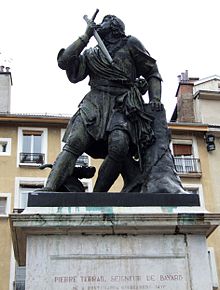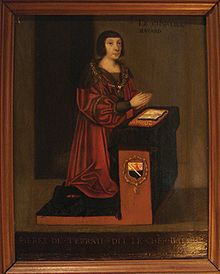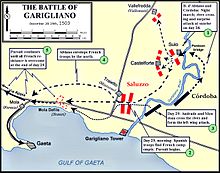- Pierre Terrail, seigneur de Bayard
-
 Pierre Terrail LeVieux, seigneur de Bayard
Pierre Terrail LeVieux, seigneur de Bayard
Pierre Terrail LeVieux, seigneur de Bayard (1473 – Rovasenda (VC) 30 April 1524) was a French soldier, generally known as the Chevalier de Bayard. Throughout the centuries since his death, he has been known as "the knight without fear and beyond reproach" (le chevalier sans peur et sans reproche). He himself however, preferred the name given him by his contemporaries for his gaiety and kindness, "le bon chevalier", or "the good knight".
Contents
Early Life
The descendant of a noble family, the head of which had fallen in battle in nearly every generation for two centuries; Bayard was born at the Château Bayard, Dauphiné (near Pontcharra, Isère). He served as a page to the young Duke Charles I of Savoy, until March 1490, when the Duke died of illness.
1490 - Service of King Charles VIII of France
1490 - Man at arms of Louis de Luxembourg
In 1490 he took service as a man-at-arms in the household of Louis de Luxembourg, the seigneur de Ligny (November, 1490); a favorite of King Charles VIII of France. As a youth, Terrail was distinguished for his looks, charming manner, and skill in the tilt-yard.
1494 - Battle of Naples
In 1494, he accompanied King Charles VIII of France's expedition into Italy to seize the Kingdom of Naples. This campaign is now known as the Italian War of 1494–1498.
1495 - Battle of Fornovo
He was knighted after the 1495 Battle of Fornovo, in which he captured a standard. Shortly afterwards, entering Milan alone in pursuit of the enemy, he was taken prisoner, but was set free without a ransom by Ludovico Sforza.
1502 - Battle of Canossa
In 1502, he was wounded at Canossa.
1503 - Battle of Garigliano
Bayard was the hero of a celebrated combat of thirteen French knights against an equal number of Spaniards, and his restless energy and valour were conspicuous throughout the Italian wars of this period. At the Battle of Garigliano it is said that he single-handedly defended the bridge of the Garigliano against 200 Spaniards, an exploit that brought him such renown that Pope Julius II tried unsuccessfully to entice him into his service.
1508 - Service of King Louis XII of France
1508 found Bayard accompanying King Louis XII against rebellious Genoa. In the battle that broke the back of the rebellion, Bayard played the role of champion and spearhead in the French assault; a breakneck cavalry charge up a mountain slope against a seemingly impregnable barricade, defended by a pike-phalanx of Genoese militia. The Genoese shattered and fled before the furious charge of Bayard and the French gendarme. Genoa subsequently fell, and Bayard entered the city in triumph behind his king.
In June of that year, King Louis played host to the Spanish king, Ferdinand. Weeks of festivities followed, including tourneys, banquets, and balls. Bayard was the champion of the first; and at the last became reacquainted with his former opponent at the Garigliano, Gonzalo Fernández de Córdoba, El Gran Capitán ("The Great Captain") of Spain.
1509 - Battle of Agnadello
In 1509, the League of Cambrai was formed between France, the Empire, Spain, and the Papacy; in an effort to wrest from Venice its territorial empire in northeastern Italy.
For this campaign, the king commissioned Bayard to raise a company of horse and foot. Up until that time, French infantry had been a despised rabble. Bayard’s company became a model for discipline, high morale, and battlefield effectiveness; and played a key role that year in rescuing the French vanguard at the Battle of Agnadello, on May 14, 1509; against the Venetian forces led by Bartolomeo d'Alviano.
1509 - Siege of Padua
Later that year, Bayard was among the French forces under Jacques de La Palice sent to join their German ally, the Emperor Maximilian I at the Siege of Padua. Though the siege ultimately failed, what early success the allies enjoyed was largely due to the combination of cool-headed leadership and dashing bravado of Bayard.
1510 - Servicing of Lucrezia Borgia
In 1510 the Duchy of Ferrara joined the alliance. Bayard was co-commander of the French contingent sent to garrison and aid the city and its Duke, Alphonso d'Este. During his eight month stay, Bayard won the admiration of the Duke and his infamous wife, the lady Lucrezia Borgia. According to his biographer, "The Loyal Servant," (likely Bayard's archer and lifelong secretary, Jacques de Mailles) the chevalier fully returned Lucrezia's admiration; considering her "a pearl" among women. Bayard would return to Ferrara on other occasions to pay his hommage to the lady; once in the company of Gaston de Foix, Duc de Nemours, just months before the Battle of Ravenna, where the Duke lost his life.
1511 - Holy league
By 1511 the League of Cambrai had collapsed due to Papal fears of the growing power of France in Italy. To counter this, Pope Julius II declared the formation of the Holy League. This alliance put France at odds with not only the Papacy, but its erstwhile ally, the Holy Roman Empire; as well as Spain and ultimately the Swiss Confederation.
In various skirmishers with Papal troops around Ferrara, Bayard continued to win renown. In one instance, he very nearly captured the Pope himself. About this time, the Duke Alphonso and Bayard found themselves under Papal Interdict. How long Bayard's period of excommunication lasted is unclear.
 Statue of Pierre Terrail LeVieux, Seigneur de Bayard, in Sainte-Anne-d'Auray, France. 1893 statue.
Statue of Pierre Terrail LeVieux, Seigneur de Bayard, in Sainte-Anne-d'Auray, France. 1893 statue.
1512 - Siege of Brescia
At the Siege of Brescia in 1512, Bayard led a wedge of dismounted men-at-arms against the defenders, himself at its tip. Several times the French assault was thrown back. Each time Bayard rallied the French forces and led them in renewed attacks. His boldness at last resulted in a severe wound to the thigh, but not before the defenses were breached and the French had entered the town.
His soldiers carried Bayard into a neighbouring mansion, the residence of a nobleman, whose wife and daughters he protected from threatened insult. Bayard was charmed by the young daughters, who sang to him nightly. Before his wound was healed, he learned that battle was imminent at Ravenna, and he hurried to depart to rejoin his comrades. But not before endowing the two daughters with a thousand gold ducats each; the money paid originally to him by the lady of the house as ransom for her family.
1512 - Battle of Ravenna
Bayard joined his commander and friend, Gaston de Foix, in time for the fateful Battle of Ravenna (1512). Though the gallantry of Bayard and the French cavalry under de'Foix carried the day, the Duke was killed in the final hour; rendering the battle a strategic loss for the French; and a personal tragedy for Bayard.
1513 - Battle of the Spurs
In 1513, when Henry VIII of England routed the French at the Battle of the Spurs (Guinegate, where Bayard's father had received a lifelong injury in a battle of 1479), Bayard, trying to rally his countrymen, found his escape cut off. Unwilling to surrender, he rode suddenly up to an English officer who was resting unarmed, and summoned him to yield; the knight complying, Bayard in turn gave himself up to his prisoner. He was taken into the English camp, but his gallantry impressed Henry as it had impressed Ludovico, and the king released him without ransom, merely exacting his word not to serve for six weeks.
1515 - Service of King Francis I of France
On the accession of Francis I in 1515, Bayard was made lieutenant-general of Dauphiné; but soon accompanied the King and army into the territory of Milan, control of which was challenged by the Swiss. At the Battle of Marignano the opposing armies engaged in a protracted and bloody struggle; which the French won largely because of the valour of Bayard, King Francis, and the French gendarme (armored lancers). After the battle, Bayard had the honour of conferring knighthood on his youthful sovereign.
1521 - Siege of Mézières
When war again broke out between Francis I and Charles V, Holy Roman Emperor, Bayard, with 1000 men, held Mézières, which had been declared untenable, against an army of 35,000, and after six weeks, compelled the imperial generals to raise the siege. This stubborn resistance saved central France from invasion, as the king had not then sufficient forces to withstand the Holy Roman Empire.
All France celebrated the achievement, and Francis gained time to collect the royal army which drove out the invaders (1521). The parlement thanked Bayard as the saviour of his country; the king made him a knight of the Order of Saint Michael, and commander in his own name of 100 gens d'armes, an honour until then reserved for princes of the blood.
1524 - Death in Italy
After allaying a revolt at Genoa, and striving with the greatest assiduity to check a pestilence in Dauphiné, Bayard was sent into Italy with Admiral Bonnivet, who, being defeated at Robecco and wounded in a combat during his retreat, implored Bayard to assume command and save the army. He repulsed the foremost pursuers, but in guarding the rear at the passage of the river Sesia, was mortally wounded by an arquebus ball (April 30, 1524).
He died in the midst of the enemy, attended by Pescara, the Spanish commander, and by his old comrade, Charles, duc de Bourbon, who was now fighting on the opposite side. Charles is reported to have said "Ah! Monsieur de Bayard... I am very sad to see you in this state; you who were such a virtuous knight!" Bayard answered,
“ "Sir, there is no need to pity me. I die as a man of honour ought, doing my duty; but I pity you, because you are fighting against your king, your country, and your oath." ” His body was restored to his friends and interred at Grenoble.
Legacy
As a soldier, Bayard was considered the epitome of chivalry and one of the most skillful commanders of the age. He was noted for the exactitude and completeness of his information on the enemy's movements, which he obtained by careful reconnaissance and a well-arranged system of espionage. In the long history of mounted warfare, he rates highly as one of the greatest cavalry leaders of all time.
In the midst of mercenary armies, Bayard remained absolutely disinterested, and to his contemporaries and his successors, he was, with his romantic heroism, piety, and magnanimity, the fearless and faultless knight (le chevalier sans peur et sans reproche). His gaiety and kindness won him, even more frequently, another name bestowed by his contemporaries, le bon chevalier.
Monuments and memorials
 Statue at Grenoble, Nicolas-Bernard Raggi sculptor
Statue at Grenoble, Nicolas-Bernard Raggi sculptor
- Equestrian statue at Pontcharra (Isère).
- Statue at Grenoble, place Saint-André.
- Bayard Mausoleum, (1625), Saint-André Collegiate church at Grenoble.
- Musée Bayard at the Château Bayard in Pontcharra.
- Statue at Charleville-Mézières, inaugurated October 2005. An earlier statue was damaged during World War I and demolished by the Germans in World War II.
- Statue in the Collège Stanislas de Paris
- Statue in Saint-Denis
- Statue in Sainte-Anne-d'Auray
- Clément-Bayard, an auto-mobile manufacturer of Mézières, was named in his honour and his image was incorporated in the logo.
- Adolphe Clément-Bayard, an entrepreneur who created the Clément-Bayard auto-mobile company in honour of the knight in 1903, and then added Bayard to his family name in 1908.
In popular culture
Bayard is a recurring character in three novels by author Samuel Shellabarger:
- Prince of Foxes
- Captain from Castile
- The King's Cavalier
The name Chevalier Bayard is used in reference to a character in Dashiell Hammett's The Dain Curse.
References
 This article incorporates text from a publication now in the public domain: Chisholm, Hugh, ed (1911). Encyclopædia Britannica (11th ed.). Cambridge University Press.
This article incorporates text from a publication now in the public domain: Chisholm, Hugh, ed (1911). Encyclopædia Britannica (11th ed.). Cambridge University Press.
Bibliography
- "Le loyal serviteur" (Jacques de Maille?), La très joyeuse et très plaisante histoire du gentil seigneur de Bayart, le bon chevalier sans peur et sans reproche, le gentil seigneur de Bayart (original edition printed at Paris, 1527)
- Symphorien Champier, Les Gestes, ensemble la vie du preulx chevalier Bayard (Lyons, 1525)
- Aymar du Rivail, Histoire des Allobroges (edition of de Terrebasse, 1844)
- Ulysse Chevalier, Bayerd in Repertoire des sources historiques
- A de Terrebasse, Hist. de Pierre Terrail, seigneur de Bayart (1st ed., Paris, 1828; 5th ed., Vienna, 1870)
- Samuel Shellabarger, Ph.D., The Chevalier Bayard, a study in fading Chivalry,(reprint Biblo and Tannen, New York, 1971)
Categories:- 1473 births
- 1524 deaths
- French military personnel
- Military leaders of the Italian Wars
- French military personnel killed in action
- Order of Saint Michael
Wikimedia Foundation. 2010.


